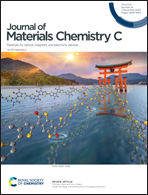Wafer-scale metal chalcogenide thin films via an ion exchange approach†
Abstract
Developing facile and controllable ways to tune the optoelectronic properties of metal chalcogenide thin films via chemical composition is of significant importance for boosting their application in various functional devices. However, for the present approaches of synthesis, the ability to tailor the chemical composition of metal chalcogenide and retain high quality nano-thin film structure is insufficient, especially for solution-based methods. Here, we demonstrate a versatile and scalable ion exchange method for the fabrication of metal chalcogenide thin films on a substrate. Based on this method, high quality continuous CdS and CdSe thin films on 2-inch sapphire have been successfully prepared and deliver excellent performances in photodetectors. Meanwhile, Cu2S and Cu2Se thin films exhibit great electrical properties with comparable conductivities (75 S cm−1 for Cu2S and 663 S cm−1 for Cu2Se) and extremely high mobilities (536.9 cm2 (V−1 × s−1) for Cu2S and 1411.8 cm2 (V−1 × s−1) for Cu2Se). Furthermore, our strategy can be easily extended not only to other metal chalcogenides to modulate their composition and properties, but also to the establishment of in-plane heterostructures via spatially controlled ion exchange by using photolithography.



 Please wait while we load your content...
Please wait while we load your content...